This image shows the polarized view of the Milky Way black hole.
They are intriguing mysteries to astronomers and science-fiction fans alike.
However, each year brings technological advances to the EHT Collaboration.
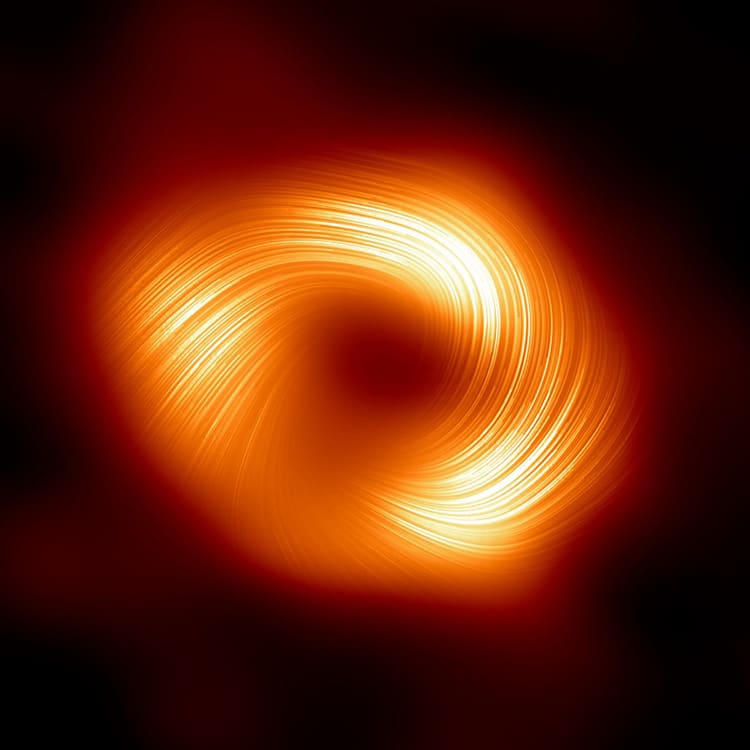
The Event Horizon Telescope (EHT) collaboration, who produced the first ever image of our Milky Way black hole released in 2022, has captured a new view of the massive object at the center of our Galaxy: how it looks in polarized light. This is the first time astronomers have been able to measure polarization, a signature of magnetic fields, this close to the edge of Sagittarius A. This image shows the polarized view of the Milky Way black hole. The lines mark the orientation of polarization, which is related to the magnetic field around the shadow of the black hole. Image (Photo: EHT Collaboration,CC BY-NC-SA)*
This step forward unlocks new understanding of how black holes work.
Both black holes appear to have magnetic fields that are similarly organized and have comparable behaviors.
Also notable, M 87* is surrounded by more gas and dust.
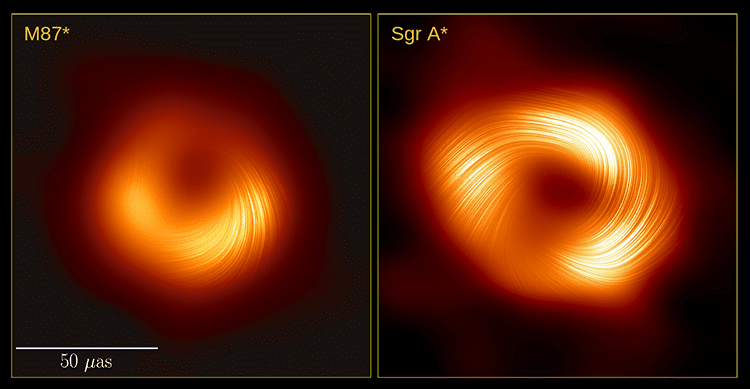
Seen here in polarized light, this side-by-side image of the supermassive black holes M87 and Sagittarius A* indicates to scientists that these beasts have similar magnetic field structures. This is significant because it suggests that the physical processes that govern how a black hole feeds and launches a jet may be universal features amongst supermassive black holes. (Photo: EHT Collaboration,CC BY-NC-SA)*
Of course, there is still much more to learn about our home galaxy and the universe itself.
Each year, technological advances help the EHT Collaboration deepen their understanding of black holes.
Each year, the Collaboration is adding telescopes and bandwidth, providing astronomers with more data.
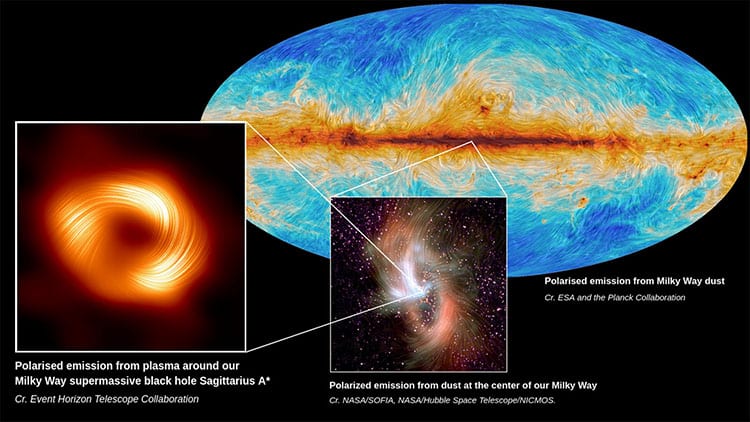
At left, the supermassive black hole at the center of the Milky Way Galaxy, Sagittarius A, is seen in polarized light, the visible lines indicating the orientation of polarization, which is related to the magnetic field around the shadow of the black hole. At center, the polarized emission from the center of the Milky Way, as captured by SOFIA. At back right, the Planck Collaboration mapped polarized emission from dust across the Milky Way. (Photo: S. Issaoun/EHT Collaboration,CC BY-NC-SA)*
It will once again be observing Sgr A* this month.
There is even potential to add telescopes in outer space to add to the EHT data.
It is fitting that we can only understand our place in the universe by coming together as a planet.
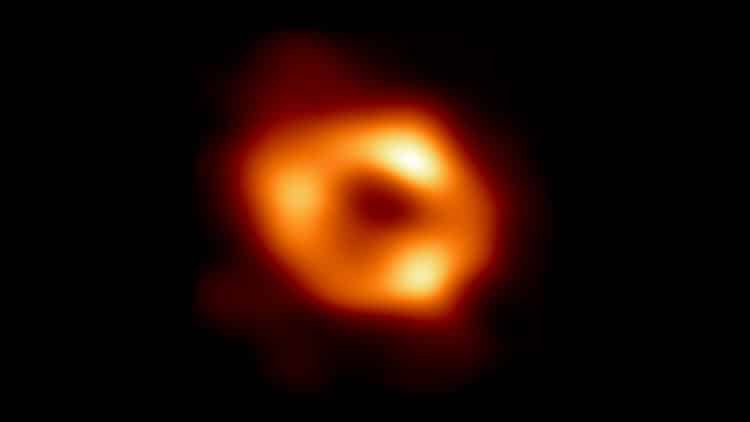
This is the first image of Sgr A, the supermassive black hole at the centre of our galaxy, with an added black background to fit wider screens. It’s the first direct visual evidence of the presence of this black hole. It was captured by the Event Horizon Telescope (EHT), an array which linked together eight existing radio observatories across the planet to form a single “Earth-sized” virtual telescope. The telescope is named after the event horizon, the boundary of the black hole beyond which no light can escape. Although we cannot see the event horizon itself, because it cannot emit light, glowing gas orbiting around the black hole reveals a telltale signature: a dark central region (called a shadow) surrounded by a bright ring-like structure. The new view captures light bent by the powerful gravity of the black hole, which is four million times more massive than our Sun. The image of the Sgr A* black hole is an average of the different images the EHT Collaboration has extracted from its 2017 observations. In addition to other facilities, the EHT network of radio observatories that made this image possible includes the Atacama Large Millimeter/submillimeter Array (ALMA) and the Atacama Pathfinder EXperiment (APEX) in the Atacama Desert in Chile, co-owned and co-operated by ESO is a partner on behalf of its member states in Europe. (Photo: EHT collaboration/European Southern Observatory,CC BY-NC-SA)*
After all, even national borders cannot escape a black hole.
At center, the polarized emission from the center of the Milky Way, as captured by SOFIA.
At back right, the Planck Collaboration mapped polarized emission from dust across the Milky Way.
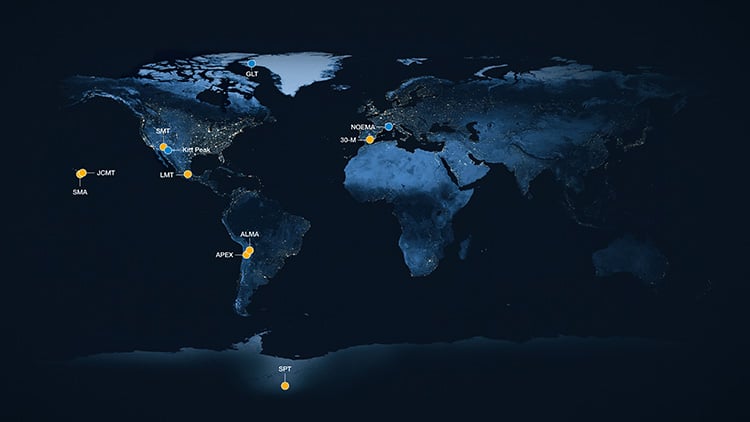
A global map showing the radio observatories that form the Event Horizon Telescope (EHT) network used to image the Milky Way’s central black hole, Sagittarius A. The telescopes highlighted in yellow were part of the EHT network during the observations of Sagittarius A* in 2017. These include the Atacama Large Millimeter/submillimeter Array (ALMA), the Atacama Pathfinder EXperiment (APEX), IRAM 30-meter telescope, James Clark Maxwell Telescope (JCMT), Large Millimeter Telescope (LMT), Submillimeter Array (SMA), Submillimetere Telescope (SMT) and South Pole Telescope (SPT). Highlighted in blue are the three telescopes added to the EHT Collaboration after 2018: the Greenland Telescope, the NOrthern Extended Millimeter Array (NOEMA) in France, and the UArizona ARO 12-meter Telescope at Kitt Peak. (Photo: M. Kornmesser/European Southern Observatory,CC BY-NC-SA)*
Its the first direct visual evidence of the presence of this black hole.